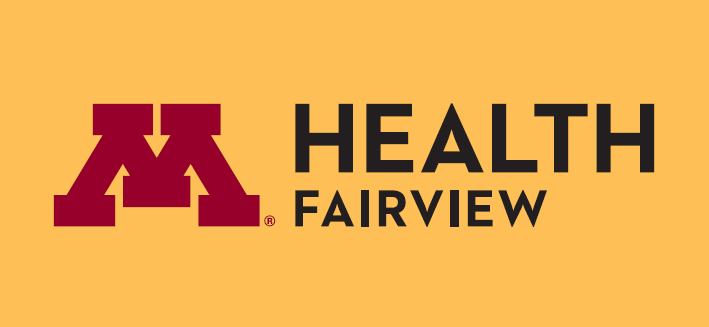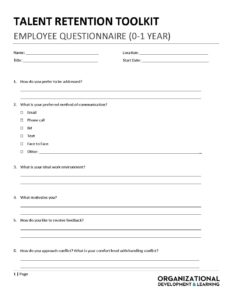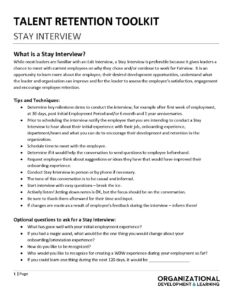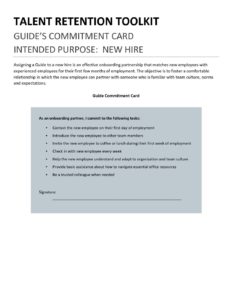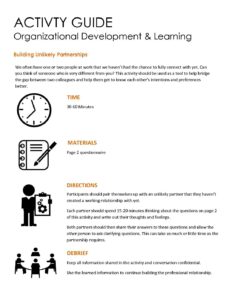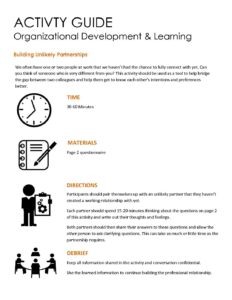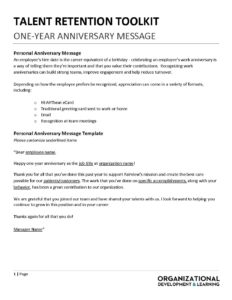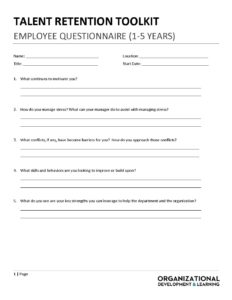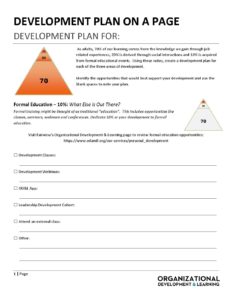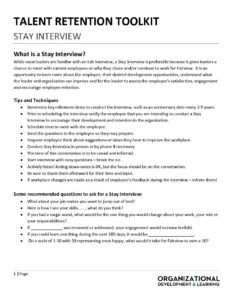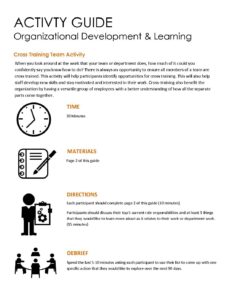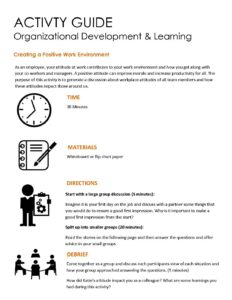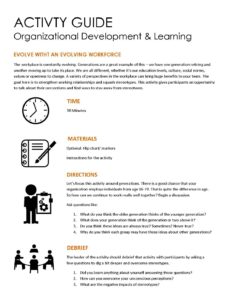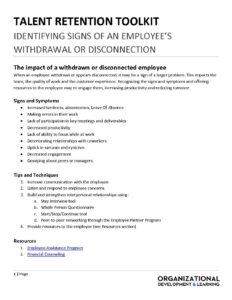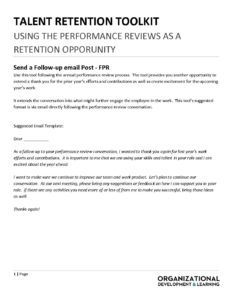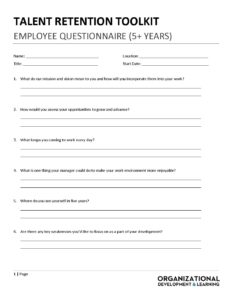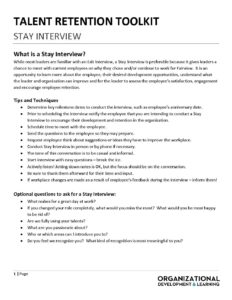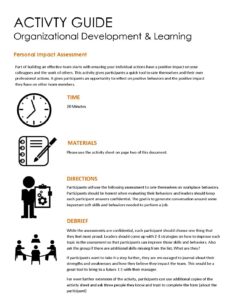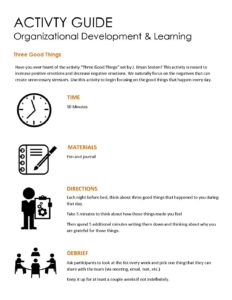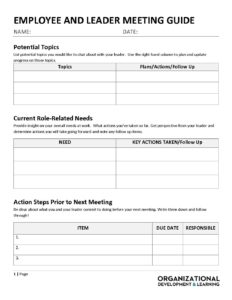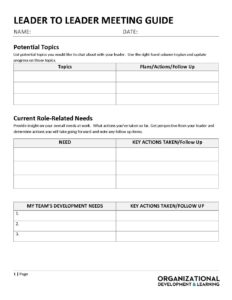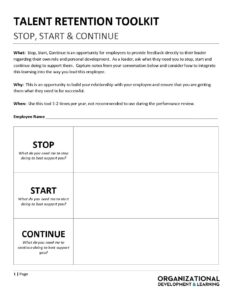RESOURCES
TALENT RETENTION TOOLKITWhy is it important for leaders to focus on retaining top talent?
Losing talent is disruptive to your team and the organization. High rates of turnover can have a direct impact on employee engagement, morale, productivity, operating margin, and much more.
While not all turnover is bad, we don’t want to lose talent that plays a role in our success. When the time, energy, and financial investments in an employee’s knowledge, skills, and abilities is lost due to attrition, we can feel surprised and even frustrated.
What can I do as a leader to help retain top talent?
A leader’s role is essential to retaining our talent. Your relationship with each employee is our first defense in retention. Your role as a leader is to:
- Welcome and engage employees from day 1 and every day thereafter.
- Foster a team culture that drives a collective responsibility for retaining peers and team members.
- Use resources and tools to support retaining your top talent.
- Support your employee’s professional development efforts.
Below are some tools that can help shape your retention strategies based on where employees are in their tenure. Of course, these strategies can also be used multiple times over the course of an employee’s time with the organization.
RESOURCES BY EMPLOYEE TENURE:
Review the Building a Team section of our Leader Toolkit for tips on posting a role, interviewing, pre-boarding, and onboarding.
30 and 90 Day New Employee Check-in
New employees and their leaders will receive email communications prior to the employee’s 30- and 90-days of employment inviting them to hold a check-in conversation. Research shows an employee’s decision to remain in an organization is tied to their initial onboarding experience. Leaders should use the 30 & 90-day milestone conversation tools and document these conversations within Talent Connect as a way to create a warmer onboarding experience, set your employee up for success in their job and reduce first-year turnover.
Review Fairview Commitments (First 30 Days)
Within the first 30 days of a new employee starting on your team, have them review the Fairview Commitments one-page summary.
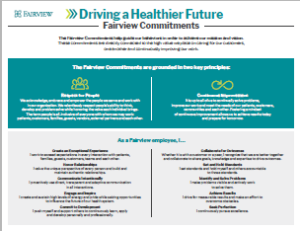
| What this tool is: | An easy-to-use summary of the Fairview Commitments and Guiding Principles. |
| Why it is important: | The Fairview Commitments are guidelines for how we do our work and interact with our colleagues, patients, and communities. |
| When to use it: | Use during initial 1:1 meetings and/or touchbases during onboarding. |
Employee Questionnaire (0-1 Year)
| What this tool is: | A useful tool that asks questions about an employee to get to know their preferences and tendencies related to work and roles. |
| Why it is important: | Getting to know your team holistically and authentically can increase employee engagement, improve working relationships and improve communication. |
| When to use it: | Use during initial 1:1 meetings and/or touchbases. |
Stay Interview Guide (0-1 Year)
| What this tool is: | A useful guide gives leaders a chance to meet with current employees on why they chose and/or continue to work for Fairview. |
| Why it is important: | It is an opportunity to learn more about the employee, their desired development opportunities, understand what the leader and organization can improve and for the leader to assess the employee’s satisfaction, engagement and encourage employee retention. |
| When to use it: | Use during initial 1:1 meetings and/or touchbases. |
Employee Guide/Buddy Resources
| What this tool is: | A useful guide, the Employee Guide/Buddy resource is an effective onboarding partnership that matches new employees with experienced employees for their first few months of employment. |
| Why it is important: | Assigning a Guide to a new hire is an effective onboarding partnership that matches new employees with experienced employees for their first few months of employment. The objective is to foster a comfortable relationship in which the new employee can partner with someone who is familiar with team culture, norms and expectations. |
| When to use it: | Use during the first 90 days of employment. |
Team Building: Building Unlikely Partnerships
| What this tool is: | Team Building Activities are brief and engaging questions or activities that help people get to know one another and build trust within a team. |
| Why it is important: | Team building activities help people become more acquainted with each other; their names, interests, experiences and memories. They are effective when people who do not usually work together, or may not know each other well, meet for a common purpose. Team Building Activities also build trust within an existing team. |
| When to use it: | Use these tools, in-person or on the phone, at the beginning of a committee meeting, the start of a huddle, during team meetings or in casual conversation with groups. |
Team Building: Survivor Problem Solving
| What this tool is: | Team Building Activities are brief and engaging questions or activities that help people get to know one another and build trust within a team. |
| Why it is important: | Team building activities help people become more acquainted with each other; their names, interests, experiences and memories. They are effective when people who do not usually work together, or may not know each other well, meet for a common purpose. Team Building Activities also build trust within an existing team. |
| When to use it: | Use these tools, in-person or on the phone, at the beginning of a committee meeting, the start of a huddle, during team meetings or in casual conversation with groups. |
Anniversary Message Template (0-1 Year)
| What this tool is: | This is a template to act as a starting block for possible messages and approaches you could take in recognizing career milestones for people on your team. |
| Why it is important: | An employee’s hire date is the career equivalent of a birthday – celebrating an employee’s work anniversary is a way of telling them they’re important and that you value their contributions. Recognizing work anniversaries can build strong teams, improve engagement and help reduce turnover. |
| When to use it: | Use this as a starting-block for creating a custom celebration message for those new employees celebrating their first anniversary. |
Fairview Commitments Example Actions
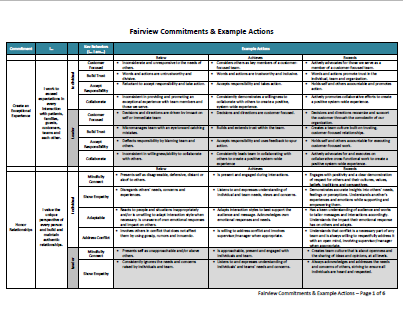
| What this tool is: | Examples of actions that demonstrate Below, Achieves, or Exceeds for each of the Fairview Commitments. |
| Why it is important: | This tool can be used for goal setting, ongoing Performance Conversations, and annual Performance Reviews. It can also be used to help employees in their development. |
| When to use it: | Use during initial 1:1 meetings and/or touchbases, during Performance Conversations/Reviews, etc. |
Employee Questionnaire (1-5 Years)
| What this tool is: | A useful tool that asks questions about an employee to get to know their preferences and tendencies related to work and roles. |
| Why it is important: | Getting to know your team holistically and authentically can increased employee engagement, improved working relationships, improved communication. |
| When to use it: | Use during initial 1:1 meetings and/or touchbases. |
Employee Development Plan on a Page
| What this tool is: | This tool provides an easy-to-use template for creating a development plan with your employees through interactive conversation. |
| Why it is important: | As adults, 70% of our learning comes from the knowledge we gain through job-related experiences, 20% is derived through social interactions and 10% is acquired from formal educational events. Using these ratios, you can assist in the design of a development plan for each of your team members. |
| When to use it: | Use during initial 1:1 meetings and/or touchbases. |
Stay Interview Guide (1-5 Years)
| What this tool is: | A useful guide to gives leaders a chance to meet with current employees on why they chose and/or continue to work for Fairview. |
| Why it is important: | It is an opportunity to learn more about the employee, their desired development opportunities, understand what the leader and organization can improve and for the leader to assess the employee’s satisfaction, engagement and encourage employee retention. |
| When to use it: | Use during initial 1:1 meetings and/or touchbases. |
Team Building: Cross-Trained Team
| What this tool is: | Team Building Activities are brief and engaging questions or activities that help people get to know one another and build trust within a team. |
| Why it is important: | Team building activities help people become more acquainted with each other; their names, interests, experiences and memories. They are effective when people who do not usually work together, or may not know each other well, meet for a common purpose. Team Building Activities also build trust within an existing team. |
| When to use it: | Use these tools, in-person or on the phone, at the beginning of a committee meeting, the start of a huddle, during team meetings or in casual conversation with groups. |
Team Building: Creating a Positive Work Environment
| What this tool is: | Team Building Activities are brief and engaging questions or activities that help people get to know one another and build trust within a team. |
| Why it is important: | Team building activities help people become more acquainted with each other; their names, interests, experiences and memories. They are effective when people who do not usually work together, or may not know each other well, meet for a common purpose. Team Building Activities also build trust within an existing team. |
| When to use it: | Use these tools, in-person or on the phone, at the beginning of a committee meeting, the start of a huddle, during team meetings or in casual conversation with groups. |
Team Building: Evolve with an Evolving Workplace
| What this tool is: | Team Building Activities are brief and engaging questions or activities that help people get to know one another and build trust within a team. |
| Why it is important: | Team building activities help people become more acquainted with each other; their names, interests, experiences and memories. They are effective when people who do not usually work together, or may not know each other well, meet for a common purpose. Team Building Activities also build trust within an existing team. |
| When to use it: | Use these tools, in-person or on the phone, at the beginning of a committee meeting, the start of a huddle, during team meetings or in casual conversation with groups. |
Identifying Signs of Withdrawal or Disconnection
| What this tool is: | This tool is meant to help a leader identify if an employee is withdrawing or disconnecting from the role, team, or organization. |
| Why it is important: | When an employee withdraws or appears disconnected, it may be a sign of a larger problem. This impacts the team, the quality of work and the customer experience. Recognizing the early indicators allows a leader to focus on intervention and actions steps to retain talent. |
| When to use it: | This tool is meant as a resource and can be reviewed or revisited at any time. |
Annual Performance Review Engagement Template
| What this tool is: | This tool provides you another opportunity to extend a thank you for the prior year’s efforts and contributions as well as create excitement for the upcoming year’s work. |
| Why it is important: | Extending the conversation into what might further engage the employee in the work will help to ensure the the employee feels valued and connected with the mission and vision of the organization. This tool’s suggested format is via email directly following the performance review conversation. |
| When to use it: | Use this tool following the annual performance review process. |
Anniversary Message Template (1-5 Years)
| What this tool is: | This is a template to act as a starting block for possible messages and approaches you could take in recognizing career milestones for people on your team. |
| Why it is important: | An employee’s hire date is the career equivalent of a birthday – celebrating an employee’s work anniversary is a way of telling them they’re important and that you value their contributions. Recognizing work anniversaries can build strong teams, improve engagement and help reduce turnover. |
| When to use it: | Use this as a starting-block for creating a custom celebration message for those new employees celebrating their first anniversary. |
Employee Questionnaire (5+ Years)
| What this tool is: | A useful tool that asks questions about an employee to get to know their preferences and tendencies related to work and roles. |
| Why it is important: | Getting to know your team holistically and authentically can increased employee engagement, improved working relationships, improved communication. |
| When to use it: | Use during initial 1:1 meetings and/or touchbases. |
Stay Interview Guide (5+ Years)
| What this tool is: | A useful guide to gives leaders a chance to meet with current employees on why they chose and/or continue to work for Fairview. |
| Why it is important: | It is an opportunity to learn more about the employee, their desired development opportunities, understand what the leader and organization can improve and for the leader to assess the employee’s satisfaction, engagement and encourage employee retention. |
| When to use it: | Use during initial 1:1 meetings and/or touchbases. |
Team Building: Personal Impact Assessment
| What this tool is: | Team Building Activities are brief and engaging questions or activities that help people get to know one another and build trust within a team. |
| Why it is important: | Team building activities help people become more acquainted with each other; their names, interests, experiences and memories. They are effective when people who do not usually work together, or may not know each other well, meet for a common purpose. Team Building Activities also build trust within an existing team. |
| When to use it: | Use these tools, in-person or on the phone, at the beginning of a committee meeting, the start of a huddle, during team meetings or in casual conversation with groups. |
Team Building: Three Good Things
| What this tool is: | Team Building Activities are brief and engaging questions or activities that help people get to know one another and build trust within a team. |
| Why it is important: | Team building activities help people become more acquainted with each other; their names, interests, experiences and memories. They are effective when people who do not usually work together, or may not know each other well, meet for a common purpose. Team Building Activities also build trust within an existing team. |
| When to use it: | Use these tools, in-person or on the phone, at the beginning of a committee meeting, the start of a huddle, during team meetings or in casual conversation with groups. |
Fairview Commitments
Use the resources on the Fairview Commitments page to help set expectations, create development goals, and align your team on an ongoing basis.
1:1 Template (Direct Report is a Leader)
| What this tool is: | If you are looking for a formal way to stay connected to your employee, this may be a helpful tool for you. Provide this 1:1 meeting guide to your employee so that they have a way to send you their topics to discuss ahead of your next 1:1 meeting. |
| Why it is important: | Use this format to guide/focus your time during your 1:1 meetings. Research shows that when employee’s feel they have a voice and can stay connected to their manager, they are more likely to stay with the organization. |
| When to use it: | We suggest you let your employee know to send it to you at least 24 hours in advance of your time together so you both have time to plan. |
1:1 Template (Direct Report is an Individual Contributor)
| What this tool is: | If you are looking for a formal way to stay connected to your employee, this may be a helpful tool for you. Provide this 1:1 meeting guide to your employee so that they have a way to send you their topics to discuss ahead of your next 1:1 meeting. |
| Why it is important: | Use this format to guide/focus your time during your 1:1 meetings. Research shows that when employee’s feel they have a voice and can stay connected to their manager, they are more likely to stay with the organization. |
| When to use it: | We suggest you let your employee know to send it to you at least 24 hours in advance of your time together so you both have time to plan. |
Stop, Start, Continue Worksheet
| What this tool is: | Stop, Start, Continue is an opportunity for employees to provide feedback directly to their leader regarding their own role and personal development. As a leader, ask what they need you to stop, start and continue doing to support them. Capture notes from your conversation below and consider how to integrate this learning into the way you lead this employee. |
| Why it is important: | This is an opportunity to build your relationship with your employee and ensure that you are getting them what they need to be successful. |
| When to use it: | Use this tool 1-2 times per year, not recommended to use during the performance review. |
,Is the Talent Retention Toolkit a Mandated Fairview Program?
What if I just don’t have time to learn another toolkit?
Consider the time and resources you will devote to the recruiting, selection, and onboarding of a new employee. There is also the cost of lost productivity, lost relationships, and progress on projects and other initiatives. For these reasons, usage of the toolkit is strongly encouraged. Find a tool or resource that works with your style and try it.
What is the best way to use the toolkit?
We suggest you spend a bit of time exploring each tool and find the one(s) that you think will best fit your leadership style and team. You will find many resources from: how to have a “stay interview” to team icebreakers that help build team cohesiveness.
How is tenure addressed?
The toolkit is designed based on leader feedback to offer different tools and activities based on 3 main tenure categories: 0 – 1 years, 1 – 5 years, and 5+ years.
Should I keep my notes and documents from the toolkit in my supervisor file?
No. Your retention activities are not part of a formal performance management processes or required recordkeeping. The tools are meant to be helpful ways and ideas for you to connect and engage with each member of your team.
What is the benefit to the toolkit?
Your rapport and knowledge of each person on your team is critical. In fact, the relationship you have is our first line of defense to unwanted attrition. Many leaders are already doing many of the items in this toolkit. The toolkit is meant to formalize the tools that we know are already being utilized as well as introduce a few more.
I have some best practices not found in the toolkit. How can I share them?
We’d love to hear them! Please email your comments, ideas, or best practices ODL@fairview.org.



